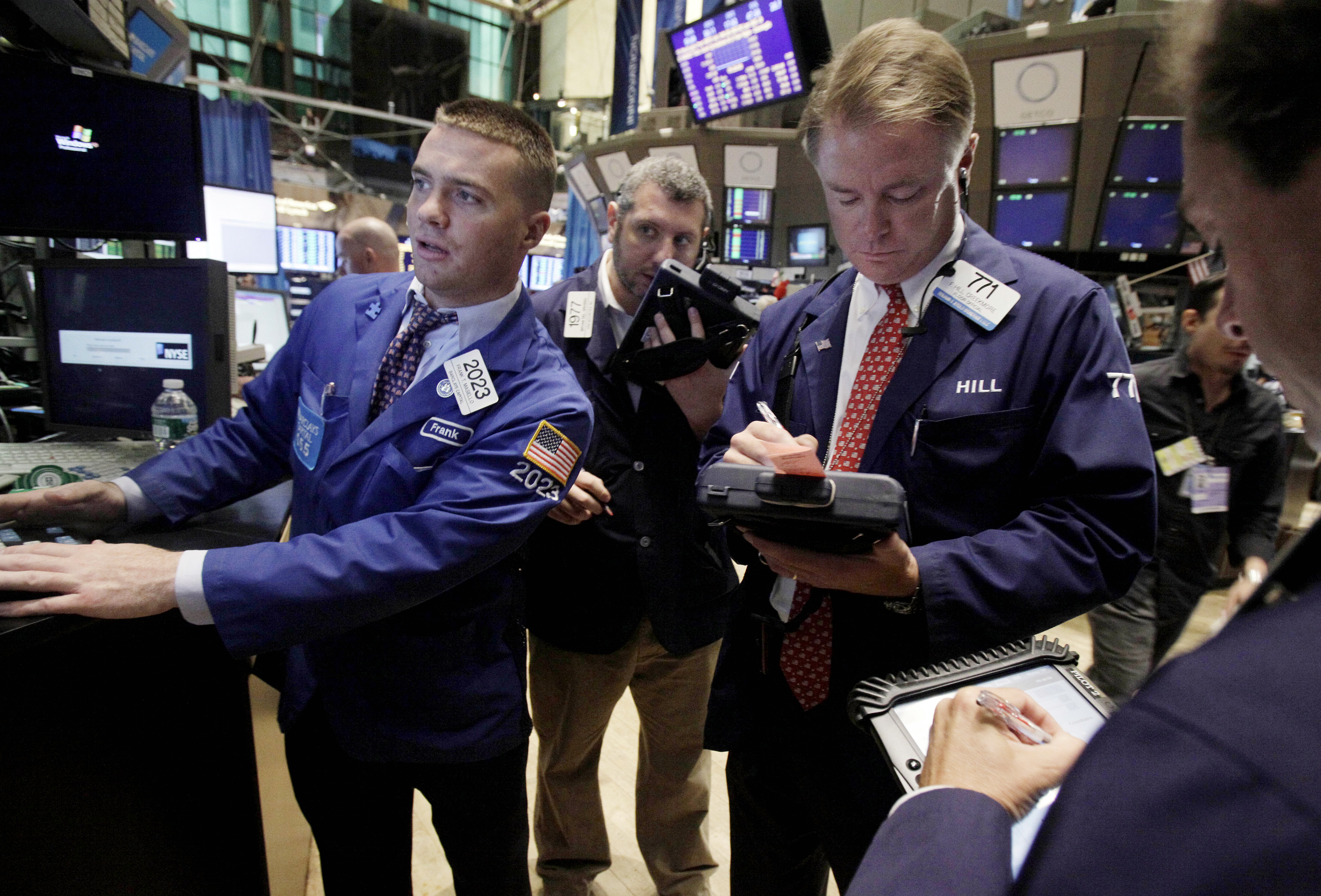

Specialist Frank Masiello, left, works with traders on the floor of the New York Stock Exchange Friday, Aug. 12, 2011. (AP Photo/Richard Drew)
The wildest week in Wall Street history ended with a second day of gains.
The Dow Jones industrial average finished Friday with a gain of 125 points. Most other times it would have been a fairly big day. By this week’s standards, it was a sleeper. Friday capped a week when the blue-chip index had four 400-point swings in a row for the first time in its 115-year history.
Trading was frantic across financial markets all week. The yield on the 10-year Treasury note hit a record low. Gold briefly topped $1,800 per ounce. Nearly every one of the 500 stocks that make up the Standard & Poor’s 500 index ended down midweek.
“It was a sharp and violent week in the stock market, but it’s my sense that the worst is over,” said Michael Kaufler, a portfolio manager at Federated Investors.
Investors reacted to every scrap of news and each whispered rumor. A credit downgrade for the U.S.. Concerns about European bank solvency. Fears of a possible new recession in the U.S. Word that the Federal Reserve would keep interest rates low for two more years because of slowing growth. A positive retail sales report. Strong earnings from a technology bellwether. Better unemployment news.
The Dow dropped 634 points Monday, its sixth-worst point drop ever, as investors responded to Standard & Poor’s withdrawal of the country’s AAA credit rating. It was the first downgrade of U.S. government debt in history. The Dow rose 429 points Tuesday, only to plunge 519 points Wednesday. It surged 423 points on Thursday following a better than expected drop in new applications for unemployment benefits.
A rebound in retail sales in July pushed the stock market higher Friday as traders looked past a Reuters/University of Michgan survey that found that consumer’s were pessimistic about their own finances and the economy. The measure of consumer sentiment fell to a 30-year low.
It was the first time since early July that the Dow and S&P index rose for two consecutive days.
Normally, such a bad consumer survey would have pushed shares sharply lower for the day, said Quincy Krosby, an investment strategist with Prudential Financial.
“But these are not normal times,” she said. Market volatility cuts both ways, sending shares way up or way down, Krosby noted. That can cause stock prices to defy economic data.

on the floor of the New York Stock Exchange Friday, Aug. 12, 2011. (AP Photo/Richard Drew)
The strong retail sales added to other bits of more positive data about the economy. The government said last week that hiring picked up slightly in July after two dismal months, though employers still are adding jobs too slowly to significantly reduce unemployment. A Thursday report showed applications for unemployment benefits fell to a four-month low. Some analysts believe recently announced layoffs will cause that number to rise in the coming weeks.
Companies that rely on an expanding economy for profits led the Dow higher. Boeing Co., Hewlett-Packard Co., and United Technologies Corp. each rose by 4 percent or more.
A separate government report on Friday showed that businesses increased their stockpiles of everything from raw materials to retail products for the 18th month in a row.
Growing inventories are usually a sign of business confidence. But in June Americans cut their spending for the first time in nearly two years. If the market’s gyrations spook consumers further, people might spend even less just as retailers stock up for the crucial holiday season.
“We are at a turning point,” said Bill Hampel, chief economist for the Credit Union National Association. “If the stock market continues to be volatile next week, I would expect a pretty serious effect on consumer confidence.”
The Dow finished Friday with a gain of 125.71 points, or 1.1 percent, to 11,269.02. It finished the week down 1.5 percent after being down as much as 6.3 percent for the week.
The broader S&P 500 index rose 6.17 points, or 0.5 percent, to 1,178.81. It finished with a the week down 1.7 percent. The technology-focused Nasdaq composite rose 15.30, or 0.6 percent, to 2,507.98. It lost 1 percent for the week.
All three major stock indexes are now down more than 10 percent from their April highs. That is a big enough drop to signify what traders call a market correction. A drop of more than 20 percent signifies a bear market, a period of sustained losses.
Financial stocks continued to slide Friday. Investment bank Morgan Stanely fell 7 percent amid concerns about U.S. banks’ exposure to the financial crisis in Europe and lawsuits related to poor-quality mortgage securities sold before the financial crisis of 2008. JPMorgan Chase & Co. and Goldman Sachs Group Inc. also lost ground.
Goodyear Tire & Rubber Co. jumped 7 percent after the company told investors that it expects revenue this quarter to offset its higher raw material costs. The company had said last month that raw material costs might hurt its profits in the second half of the year.
DeVry Inc. plunged nearly 17 percent, the most in the S&P 500, after the company said that new student enrollment tumbled this summer. For-profit education companies are under pressure to raise their admissions standards so that students will be more likely to find jobs and pay off their government-backed loans. That has caused their share prices to fall sharply this year.
The yield on the 10-year Treasury note fell to 2.26 percent from 2.34 percent late Thursday. It had fallen to a record low of 2.03 percent earlier in the week.
Two stocks rose for every one that fell on the New York Stock Exchange. Volume was above average at 5 billion shares, but lighter than earlier in the week when it reached 9.7 billion shares, the fourth-highest on record.
__
DANIEL WAGNER,AP Business Writers
DAVID K. RANDALL,AP Business Writers
Wagner reported from Washington.
Copyright 2011 The Associated Press.



